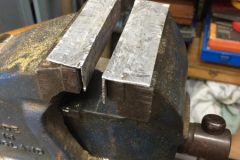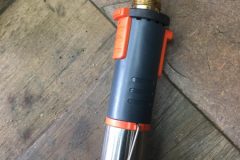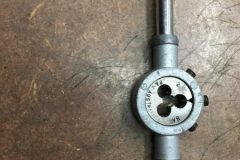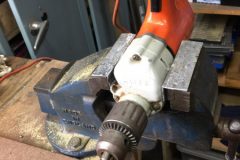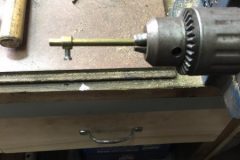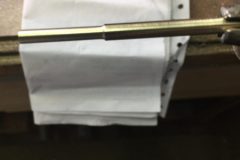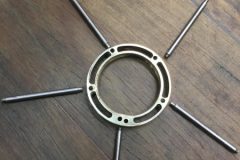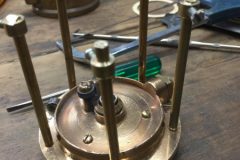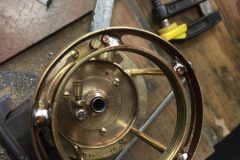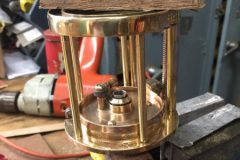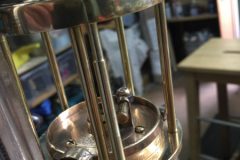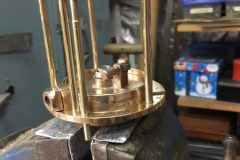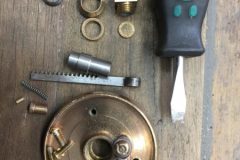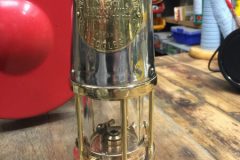The following writing was submitted by Bosuns Mate (a pseudonym) in NSW Australia. Bosuns Mate is an avid collector and restorer of miner’s lamps in NSW Australia.
In this post, Bosuns Mate explains with photos how he went about rebuilding a Protector GR6S lamp.
Searching through a box of bits and pieces, I found that I had nearly enough parts to build a Protector GR6S, probably the most common of lamps to be found. However, some of the parts had come from a Type 6 that had been butchered to make it into an electric table lamp. The steel pillars from the Type 6 were too short for a GR6S, and the sliding pillar was also missing, so I decided to make some brass pillars, without the benefit of using a lathe. The steel pillars had been removed once before and were easily punched out. Had they not been, they would have to be carefully cut with a hacksaw.
Please note, if you’re going to attempt restoring a lamp, it’s much easier if you have at least a basic knowledge of metalwork, and a few basic tools.
To start with, all British lamps have Imperial threads, usually British Association (BA), or British Standard Whitworth (BSW). European lamps have Metric threads. Most of us know someone who can assist or offer advice.
Being without a lathe does not necessarily mean you’re stuck, as quite a bit can be achieved with an old electric hand drill and a couple of files.
The pillars are usually 3/16” in diameter. To start with, a Stock & Die size 2BA thread must be cut into the bottom ends of the pillars, while the other ends have to be reduced in diameter to fit into the relevant pillar holes to make up the lamp’s cage.
The pillars’ threaded bottom ends are screwed into the lamp’s cage construction, while the top ends slot into the provided holes. The thread size is 2BA, as shown in the picture of a stock and die.
By measuring the pillar to the exact size and placing some sort of ‘stop’ on it, you can freely apply a flat file to the rotating end in question, to create the shoulder intended to fit into the cage holes. For this purpose, it is better if the file has one smooth edge, like a 10” Flat File.
Depending on whether you can reverse the drill, you might find it quicker to hold the file level, and back to front. The sliding pillar must be done at both ends.
I found that a perfect answer to getting the exact length is to use the internal brass piece from an electrical connector, the Blue Point (BP) connector, which is a perfect size. Any electrician should have something similar in a scrap box.
When you get this all together, as shown in the pictures, apply a dab of solder to the ends of each pillar. This will hold them solid.
Factory-made ones have the ends belled over in a machine. This is difficult to achieve without specialist tools, and not necessary, as the use of the lamp is for your pleasure and amusement, and a Mines inspector isn’t going to check on your work.
The bottom plate, with the striker assembly on it, is easy to do if the Flint isn’t stuck. Stuck flints are quite common in lamps that have not been used for a long time. To fix this you need an old broad blade screwdriver with a sharpened blade end, and a slot filed into the screwdriver blade edge (pls refer to the images below). This will enable you to remove the double slotted dome nut that secures the striker shaft and Flint wheel, while at the same time gently holding the small gear wheel at the bottom of the shaft with a pair of standard pliers. You should then be able to push the old Flint out and then reassemble the striker.
All you need now, is a bonnet, fuel cell, glass, two gauzes, and two gaskets, and you have yourself a rebuilt Protector GR6S lamp.
More about Bosuns Mate (BM):
In the merchant navy, the Bosons Mate (BM) was known as the ‘Lampy‘. His duty was to maintain the lamps, and trim the wicks before electricity made it into the mainstream. Later the Bosons Mate would become the 2IC of the deck crew, and a Petty Officer, known as the Lamp Trimmer. Nowadays it is a rank and job that has now been consigned to the dustbin of history, but back then it wasn’t when BM was sailing the Deep Seas.

